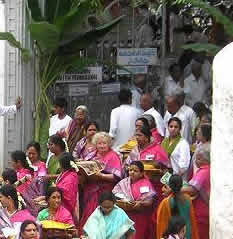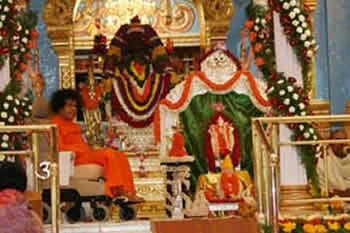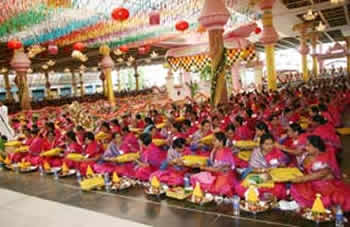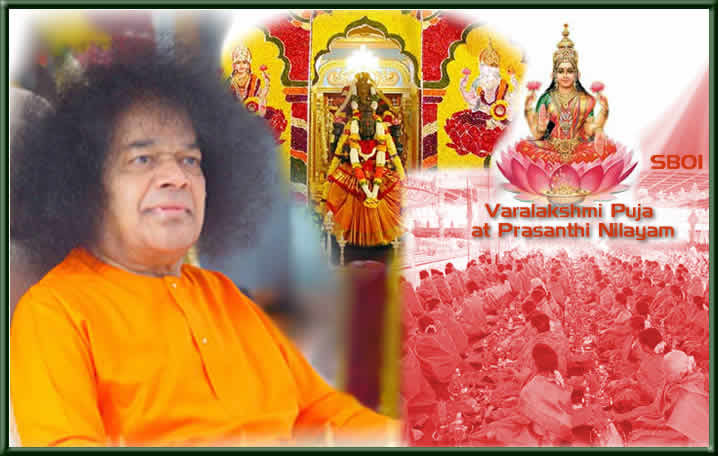|
Inspire Me
|
Pictures
|
Audio-Video |
Wallpapers|
Greeting-cards
|SBOI-Group
|
Sai news
4th August - Vara Lakshmi
Vratham
Images from 4th August - Vara Lakshmi
Vratham
<< The previous issue of
Prashanthi Bulletin
Next issue of Prashanthi
Bulletin >>
Today morning the "Vara Lakshmi
Vratham" started out with Lakhsmi Puja in Puttaparthi. The traditional ritual
of puja (pooja) was performed to Godess Lakshmi by Sai Baba devotees in huge
numbers. The
pooja to Godess lakshmi was incomparable and very auspicious since it was
preformed in the holy presence of Sathya Sai Baba. Swami attended the puja and
granted wonderful darshan & blessings to all the devotees.
this Vratam was performed in the immediate Divine
Presence of Bhagawan Sri Sathya Sai Baba in Sai Kulwant Hall. A large number of
ladies occupied the Hall .
It was a sight to see their joyful visages, performing the Puja meticulously to
the instructions of the priests. Legend has it that this Vratam was narrated by
Lord Siva Himself. Here in Prasanthi Nilayam, they were fortunate to perform the
same in the Divine Presence of Sai Siva Himself.
The Puja began with Ganapati Prarthana (Ganapati
worship). Puja materials were supplied to the participants of the Vratam.
During the course of the Puja, the head priest narrated the legend of the Vratam, which reads as follows: Goddess
Parvati once asked Lord Siva to recommend her a Vratam, which would be
beneficial for the womenfolk on earth who seek prosperity. Then, Lord Siva
preached
 her about Varalakshmi Vratam (as mentioned in Skanda Puranam). To
illustrate the sanctity of this Vratam, Lord Siva then narrated the story of one
Charumati. Charumati was a true Pativrata (devoted to husband in all sincerity).
Pleased with her true and undivided devotion to her husband, Goddess Lakshmi
appeared in her dream and advised her to undertake the Varalakshmi Vratam on the
auspicious day of Sravana Shukla Shukra Varam. Charumati performed this Puja
with utmost devotion, the same day, in the dream itself (Manasika Puja). The
next day she narrated this dream to her husband, and with his full consent, to
all other womenfolk in town. On the auspicious day, she did not fail to perform
Varalakshmi Vratam as prescribed to her by Goddess Parvati. Then some miracles
took place. Everything seemed bountiful. Ever since, this Vratam has been
regularly performed in households. her about Varalakshmi Vratam (as mentioned in Skanda Puranam). To
illustrate the sanctity of this Vratam, Lord Siva then narrated the story of one
Charumati. Charumati was a true Pativrata (devoted to husband in all sincerity).
Pleased with her true and undivided devotion to her husband, Goddess Lakshmi
appeared in her dream and advised her to undertake the Varalakshmi Vratam on the
auspicious day of Sravana Shukla Shukra Varam. Charumati performed this Puja
with utmost devotion, the same day, in the dream itself (Manasika Puja). The
next day she narrated this dream to her husband, and with his full consent, to
all other womenfolk in town. On the auspicious day, she did not fail to perform
Varalakshmi Vratam as prescribed to her by Goddess Parvati. Then some miracles
took place. Everything seemed bountiful. Ever since, this Vratam has been
regularly performed in households.
OFFICIALVARALAKSHMI VRATAM REPORT:
VARALAKSHMI VRATAM AT PRASANTHI NILAYAM (4th August
2006)
Speaking on the significance of Varalakshmi Vrata in the year 2000,
Bhagavan said,
“Since ancient times, the women of Bharat have upheld the dignity and
honour of the family and the community at large. The worship of goddess
Varalakshmi earned them Her grace and they could accomplish all this.
Varalakshmi is one who grants all the boons that women pray for. She
confers on women all the eight types of wealth. Noble women like
Savitri, Damayanti, Chandramati and Sumati
 accomplished mighty
tasks only due to the grace of Varalakshmi. Worship of Varalakshmi
confers wealth, prosperity and bliss.” accomplished mighty
tasks only due to the grace of Varalakshmi. Worship of Varalakshmi
confers wealth, prosperity and bliss.”
Varalakshmi Vratam is a festival to propitiate Sri Varalakshmi (Mahalakshmi)
- the consort of Lord Vishnu, who is the abode of all auspiciousness,
prosperity and wealth. The Vratam is performed on the Sravana Sukla
Sukra Varam, that is, the Friday immediately following the full moon day
(Purnima) in the auspicious month of Sravanam (corresponding to August -
September). This Vratam is undertaken by the Sumangalis (whose husbands
are still living) for good progeny, good health, and wishing long life
for the husbands.
On this auspicious day, Bhagawan came to Sai Kulwant Hall at 7.30 a.m. ,
while a Nadaswaram troupe of musicians followed Bhagawan playing
sonorous notes befitting the occasion. The Hall was aesthetically
decorated for the festival. A beautifully decorated idol of Varalakshmi
adorned the dais of the Hall. Before the Puja commenced, Bhagawan went
amidst the seated ladies in the Hall. The head priest elaborated on the
significance of the occasion. He informed the gathering of ladies that
to perform this Puja in the immediate Divine Presence of Bhagawan was a
great boon for all of them. The Puja commenced with worship of Ganapati.
Then the priests enunciated the Mantras which were repeated by the vast
gathering of 1,600 ladies. All along, the Sri Suktam, which forms an
important part of this Puja was chanted by the priests. The ladies tied
Toram (sacred yellow thread) on each other's wrist as a mark of
protection and blessings of the Divine Mother. As instructed by the
priests, they sprinkled Akshata (sacred yellow rice) on each other and
also exchanged the customary winnowing pan, which symbolises charity.
The priest then explained the legend behind this Puja (mentioned in the
next paragraph of this report). At the end, Bhagawan was offered Arati
after which an announcement was made that a sumptuous lunch was arranged
for the participants
 in the South Indian Canteen. in the South Indian Canteen.
There are several legends associated with this festival. Goddess Parvati
once asked Lord Siva to suggest her a Vratam, which would be beneficial
for the womenfolk on earth who seek prosperity. Then, Lord Siva preached
her about Varalakshmi Vratam. To illustrate the sanctity of this Vratam,
Lord Siva narrated the story of one Charumati. Charumati was a true
Pativrata (devoted to husband in all sincerity). Pleased with her true
and undivided devotion to her husband, Goddess Lakshmi appeared in her
dream and advised her to undertake the Varalakshmi Vratam on the
auspicious day of Sravana Sukla Sukra Varam. Charumati performed this
Puja with utmost devotion, the same day, in the dream itself. The next
day she narrated this dream to her husband, and with his full consent,
to all other womenfolk in town. On the auspicious day, she did not fail
to perform Varalakshmi Vratam and reaped immense benefit. Ever since,
this Vratam has been regularly performed in households.
On this evening, Bhagawan came to the Hall at 3.10 and sat on the dais
listening to the Vedic chants. The devotees and students had a
fulfilling Darshan of the Lord. After Bhajans and Arati, the day's
proceedings ended and Bhagawan retired for the day.
Images
from 4th August - Vara Lakshmi Vratham
VARALAKSHMI VRATHAM
Varalakshmi Vratam is an important pooja
performed by many women in the states of Andhra Pradesh, Karnataka and some
parts of Tamil Nadu.
VaraLakshmi Vratham is dedicated to the
Goddess Lakshmi , the consort of Lord Vishnu. Varlakshmi Vratham is celebrated
on the second Friday of the bright fortnight in the month of Aashata or Aadi ,
corresponding to the English month of July-August. This festival is mostly
observed by women seeking the blessings of Lakshmi for their families.
Mahalakshmi Ashtakam
Namastestu
Mahaamaaye Shreepeete Surapoojite
Shankha Chakra Gadaa Haste Mahaalakshmi Namostu Te.
Meaning: O Mahaamaaya, abode of fortune,
worshipped by the Gods, I salute Thee. O Mahaalakshmi, one who has conch, disc
and mace in Her hands, obeisance to Thee.
Namaste
Garudaroode Koalaasura Bhayankari
Sarva Paapa Hare Devi, Mahaalakshmi Namostu Te.
Meaning: My salutations to Thee, who
rides Garuda and are a terror to demon Kola; O Devi Mahaalakshmi, remover of all
miseries, my obeisance to Thee.
Sarvajne
Sarva Varade Sarva Dushta Bhayankari
Sarva Duhkha Hare Devi Mahaalakshmi Namostu Te.
Meaning: O Devi Mahaalaksmi, who is the
embodiment of knowledge, giver of all boons, a terror to all the wicked, remover
of all sorrows, obeisance to Thee.
Siddhi
Buddhi Prade Devi Bhukti Mukti Pradaayini
Mantra Moorthe Sadaa Devi Mahaa Lakshmi Namostu Te.
Meaning: O Devi, You give success and
intelligence and worldly enjoyment and liberation (as well). Thou hast always
the mystic symbols (Mantra) as Thy form, O Mahaalakshmi, obeisance to Thee.
Aadyantarahite Devi Aadya Shakte Maheshvari
Yogaje Yogasambhoote Mahaalakshmi Namostu Te.
Meaning: O Devi, Maheshwari, You are
without a beginning or an end , You are the Primeval energy, You are the
greatest ruler, You are born of Yoga. O Mahaalakshmi, obeisance to Thee.
Sthoola
Sookshmah Mahaa Raudre Mahaa Sakthe Mahodaye
Mahaa Paapa Harey Devi Mahaalakshmi Namostu Te.
Meaning: O Mahaalakshmi, You are both
gross and subtle, most terrible (for the wicked), You are the embodiment of
great power and prosperity and You are remover of all sins, obeisance to Thee.
Padmaasanasthite Devi Parabrahma Svaroopini
Paramesi Jaganmaata, Mahalakshmi Namostu Te.
Meaning: O Devi, You are seated on the
lotus, You are the Supreme Brahman, You are the great Lord and Mother of the
universe, O Mahaalakshmi, obeisance to Thee.
Svetaambaradhare Devi Naanaalankaara Bhooshite
Jagatsthite Jaganmaatah, Mahaalakshmi Namostu Te
Meaning: O Devi, You are dressed in
white garments and decked with various kinds of ornaments, Thou art the mother
of the universe and its support, O Mahaalakshmi, obeisance to Thee.
Mahaalakshmyaastaka Stottram Yad Pated Bhaktiman Naraha.
Sarva Siddhimavaapnoti Mahaalakshmi Prasaadataha.
Meaning: Whoever with devotion reads
this hymn to Mahaalakshmi composed in eight stanzas, attains all success through
the Grace of Mahaalaksmi.
Ekakaale
Patennityam Mahaapaapa Vinaashanam
Dvikaalam Yah Patennityam Dhana Dhaanya Samanvitaha
Meaning: Whoever reads this hymn at
least once a day will have all their sins destroyed; those who recite it twice
will be blessed with wealth and prosperity.
Trikaalam
Yah Patennityam Mahaa Shatru Vinaashanam
Mahaalakshmir Bhavennityam Prasannaa Varadaa Shubhaa
Meaning:Those who recite this three
times in a day will have all their enemies destroyed. They will be always be
blessed by the Goddess Mahalakshmi.
VARALAKSHMI VRATHAM Varalakshmi Vratam is an important pooja performed
by many women in the states of Andhra Pradesh and Karnataka and some
parts of Tamil Nadu.The Hindu festival going by the name 'Vara Lakshmi
Vrata' is celebrated on the last Friday of the bright fortnight in the
month of Ashadha, also called Adi, which corresponds to the English
months of July-August.
Significance
Eight forces or energies are recognised and they are known as Sri
(Wealth), Bhu (Earth), Sarasvati (learning), Priti (love), Kirti (Fame),
Santi (Peace), Tushti(Pleasure) and Pushti(Strength). Each one of these
forces is called a Lakshmi and all the eight forces are called the Ashta
Lakshmis or the eight Lakshmis of the Hindus. Vishnu is also called
Ashta Lakshmi Padhi which is equivalent to saying that he is the asylum
for the eight-Lakshmis or forces. In fact, Vishnu representing the
preservative aspect of the universe, radiates these forces from him.
These forces are personified and worshipped as Lakshmis, since abstract
force is beyond the comprehension of the ordinary people. As health,
wealth and prosperity depend upon the rythmic play of these forces, the
worship of Lakshmi is said to be to obtain these three. Only a woman can
sympathise with women. Lakshmi is a woman. So she will more readily
sympathise with women. Hence this festival is observed largely by women,
invoking the blessings of Lakshmi on them, their husbands and their
children.
Legend
As the legend goes, this is a pooja that was pronounced by no other than
Lord Parameswara to be performed by his consort Parvathi to seek
prosperity and happiness for the family. Thus it came to be emulated by
married women who sought boons (varam) for the health, wealth and
knowledge for the entire family. In some cases, women prayed for being
blessed with children. The prescribed day for the pooja is the Friday of
the month of Sravan in the fortnight known as Sukla paksha, preceding
the full moon day.
Story
On one occasion, Parvati and Parameswara were engaged in a game of
chess. Parvati was winning game after game, but Parameswara is said to
have claimed the victory at each games, wantonly, to her intense
chagrin. So Parvati wanted to have an umpire and one Chitranemi, a
creation of Parameswara, was chosen. As an underling of Parameswara, he
sided with him most unjustly. This provoked Parvati's anger and she
cursed Chitranemi that he should become a leper for discharging his duty
in most unfair manner.
When Chitranemi begged Parvati's forgiveness and Parameswara added his
entreaties to it, she is said to have relented and modified the curse by
adding that he would be cured of his leprosy by observing the Vara
Lakshmi Vrata. By doing this Chitranemi was, it is said, rid of the
loathsome disease.
The history of the origin Of the Vara Lakshmi Vrata is rather
interesting. Lakshmi is said to have visited a pious woman by name
Sarmadi, living in the city of Kuntinapura in Magadha (Bihar), in in one
of her dreams and expressed her satisfaction at her devotion to her
children. When she woke UP from her sleep, she took a bath and
worshipped Lakshmi to ensure her blessings. When the other ladies heard
of her dream and her worship of Lakshmi, they too began to worship her,
and the custom is then said to have spread everywhere throughout the
land in course of time.
History
In the kingdom of Magadha of yore, there lived a brahmin woman called
Charumathi in a town named Kundina. The prosperous town was the home of
Charumathi and her husband. She devotedly served her husband and her
parents-in-law. Impressed by her piety, Goddess Mahalakshmi appeared in
her dream and asked her to worship Vara-Lakshmi (literally, boon
granting - goddess of wealth) and seek to fulfill her wishes.
Varalakshmi is yet another form of Lord Vishnu's consort, Lakshmi, the
goddess of wealth. Thus was prescribed the Friday of Sravana month
preceding the full moon day for the worship.
When Charumathi explained her dream to her family, she found them
encouraging her to perform the pooja. Many other women of the town also
joined her in performing the pooja in a traditional way and offered many
sweet dishes to the Goddess Varalakshmi. They prayed with deep devotion:
"Padmaasane Padmakare sarva lokaika poojithe
Narayana priyadevi supreethaa bhava sarvada"
The well dressed women made offerings of delicious feast with utmost
devotion. As they went round the deity in prayer, dazzling jewelry is
said to have appeared as ornaments on the bodies of these worshippers
and their houses filled with riches. They rewarded the priest who
assisted them in performing the pooja and they all partook in the feast.
The women expressed their gratitude to Charumathi who shared her dream
and helped them become prosperous. This pooja came to be practiced year
after year by women. Done with devotion, it is said that boons would be
granted and thus many wishes would be realized.
This pooja can be done with no restriction to caste or creed. To this
day, the faithful of modern times observe this tradition.
- Updated
Sai News & latest Photos
»»
Home
Inspire Me
|
Pictures
|
Audio-Video |
Wallpapers|
Greeting-cards
|SBOI-Group
|
Sai news
Images from 4th August - Vara Lakshmi
Vratham
|




